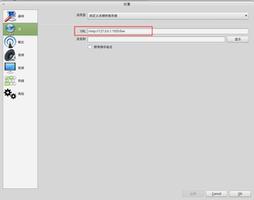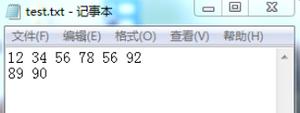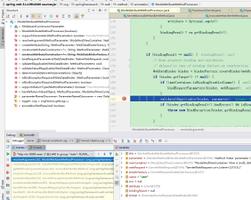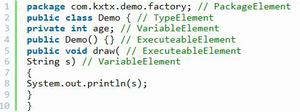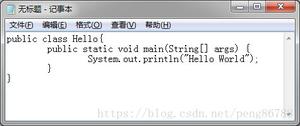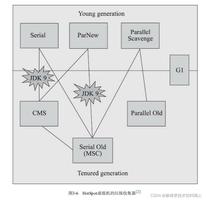java面试-线程池使用过吗,谈谈对ThreadPoolExector的理解

一、架构说明:
二、为什么使用线程池,优势是什么?
线程池做的工作主要是控制运行的线程的数量,处理过程中将任务放入队列,然后在线程创建后启动这些任务,如果线程数量超过了最大数量,那么超出数量的线程排队等候,等其它线程执行完毕,再从队列中取出任务来执行。
特点:线程复用、控制最大并发数量、管理线程
优点:
- 降低资源消耗。通过重复利用已创建的线程来降低线程创建和销毁造成的消耗。
- 提高响应速度。当任务到达时,任务可以不需要的等到线程创建就能立即执行。
- 提高线程的可管理性。线程是稀缺资源,如果无限制的创建,不仅仅会消耗系统资源,还会降低体统的稳定性,使用线程可以进行统一分配,调优和监控。
2、特点:
newFixedThreadPool():执行长期任务,性能好很多
newSingleThreadExecutor():一个任务一个任务顺序执行
newCachedThreadPool():是一种用来处理大量短时间工作任务的线程池
代码演示:
public class MyThreadPoolDemo { public static void main(String[] args) {
// ExecutorService executorService = Executors.newFixedThreadPool(5); //一次有5个处理线程
// ExecutorService executorService = Executors.newSingleThreadExecutor();
// ExecutorService executorService = Executors.newCachedThreadPool();
//真实项目中使用
ExecutorService executorService = new ThreadPoolExecutor(2, 3, 1L, TimeUnit.SECONDS,
new LinkedBlockingQueue<>(5),
Executors.defaultThreadFactory(),
new ThreadPoolExecutor.DiscardOldestPolicy());
try {
//模拟10个用户来办理业务
for (int i = 0; i < 12; i++) {
// try {
// TimeUnit.SECONDS.sleep(1);
// } catch (InterruptedException e) {
// e.printStackTrace();
// }
executorService.execute(() -> {
System.out.println(Thread.currentThread().getName()+" 办理业务");
});
}
} catch (Exception e) {
e.printStackTrace();
}finally {
executorService.shutdown();
}
}
}
三、ThreadPoolExecutor
public ThreadPoolExecutor(int corePoolSize,int maximumPoolSize,
long keepAliveTime,
TimeUnit unit,
BlockingQueue<Runnable> workQueue,
ThreadFactory threadFactory,
RejectedExecutionHandler handler) {
if (corePoolSize < 0 ||
maximumPoolSize <= 0 ||
maximumPoolSize < corePoolSize ||
keepAliveTime < 0)
throw new IllegalArgumentException();
if (workQueue == null || threadFactory == null || handler == null)
throw new NullPointerException();
this.corePoolSize = corePoolSize;
this.maximumPoolSize = maximumPoolSize;
this.workQueue = workQueue;
this.keepAliveTime = unit.toNanos(keepAliveTime);
this.threadFactory = threadFactory;
this.handler = handler;
}
四、线程池七大参数介绍
corePoolSize:线程池的核心线程数
maximumPoolSize:线程池的最大线程数,此值必须大于等于1
keepAliveTime:多余的空闲线程的存活时间,线程池数量超过corePoolSize,空闲时间达到keepAliveTime值时,多余空闲线程会被销毁直到剩下corePoolSize个线程为止
TimeUnit:keepAliveTime的单位
workQueue:任务队列,被提交但是尚未被执行的任务
threadFactory:设置创建线程的工厂
RejectedExecutionHandler:拒绝策略,当提交任务数超过maxmumPoolSize+workQueue之和时,任务会交给RejectedExecutionHandler 来处理
五、线程池底层工作原理
1、在创建了线程池后,等待提交过来的任务请求。
2、ThreadPoolExecutor执行execute方法,线程池会做如下判断:
- 如果当前运行的线程少于corePoolSize,则创建新线程来执行任务(注意,执行这一步骤需要获取全局锁)。
- 如果运行的线程等于或多于corePoolSize,则将任务加入BlockingQueue。
- 如果无法将任务加入BlockingQueue(队列已满),则创建新的线程来处理任务(注意,执行这一步骤需要获取全局锁)。
- 如果创建新线程将使当前运行的线程超出maximumPoolSize,线程池会启用拒绝策略来执行。
3、当一个线程完成任务,会从队列中取下一个任务来执行
4、当线程空闲时间达到keepAliveTime值时,线程池会判断,如果当前线程数大于corePoolSize,那么这个线程就会被停掉。
所以线程池的所有任务完成后最终会收缩到corePoolSize的大小。
六、线程池的4种拒绝策略
当队列和线程池都满了,说明线程池处于饱和状态,那么必须采取一种策略处理提交的新任务
- AbortPolicy(默认):直接抛出现RejectedExecutionException异常。
- CallerRunsPolicy:该策略既不会抛弃任务,也不会抛出异常,而是将某些任务回退到调用者,从而降低新任务的流量
- DiscardOldestPolicy:丢弃队列里等待最久的任务,然后把当前任务加入队列中尝试再次提交当前任务。
- DiscardPolicy:直接丢弃掉,不予任何处理也不抛出异常。
六、工作中线程池实际使用
public class ThreadPoolExecutorDemo { public static void main(String[] args) {
ExecutorService executorService = new ThreadPoolExecutor(2, 3, 1L, TimeUnit.SECONDS,
new LinkedBlockingQueue<>(5),
Executors.defaultThreadFactory(),
new ThreadPoolExecutor.DiscardPolicy());
}
}
六、线程池配置合理线程数
查看电脑cpu核数:
public class CPUCoresDemo { public static void main(String[] args) {
System.out.println(Runtime.getRuntime().availableProcessors());
}
}
1、CPU密集型:任务需要大量的运算,而没有阻塞,CPU一直全速运行。
CPU密集型任务配置尽可能的少的线程数量,
公式:CPU核数 + 1个线程的线程池。
2、IO密集型:任务需要大量的IO,即大量的阻塞
由于IO密集型任务线程并不是一直在执行任务,可以多分配一点线程数,如 CPU * 2 。
使用公式:CPU 核数/(1-阻塞系数);其中阻塞系数在 0.8 ~ 0.9 之间。
以上是 java面试-线程池使用过吗,谈谈对ThreadPoolExector的理解 的全部内容, 来源链接: utcz.com/z/393531.html

